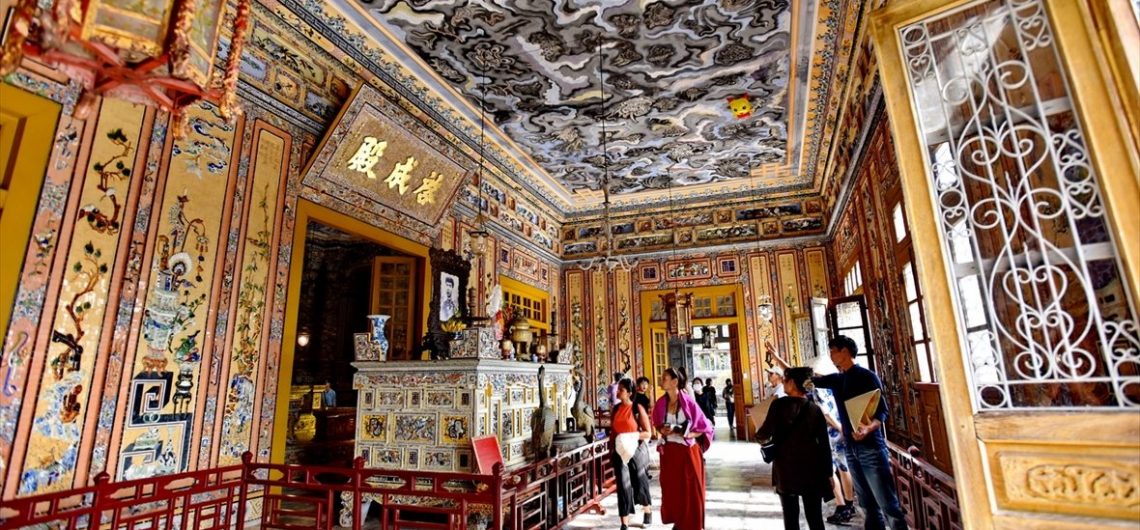Khai Dinh’s Tomb in Hue is not only considered the most beautiful royal tomb but also a place that embodies many other “best” qualities, making it a must-visit destination for travelers when coming to this dreamy city. With meticulously designed, splendid architectural works that cleverly combine Eastern and Western cultural elements, Khai Dinh’s Tomb stands out as a prominent historical relic in the ancient capital. It has become a favorite check-in spot for many young people due to its numerous ideal photo opportunities.
To better understand this site, let’s explore it in this article by DanangPrivateCar.com. In this article, we will provide a comprehensive travel guide to Khai Dinh’s Tomb from beginning to end for those who are planning to visit.
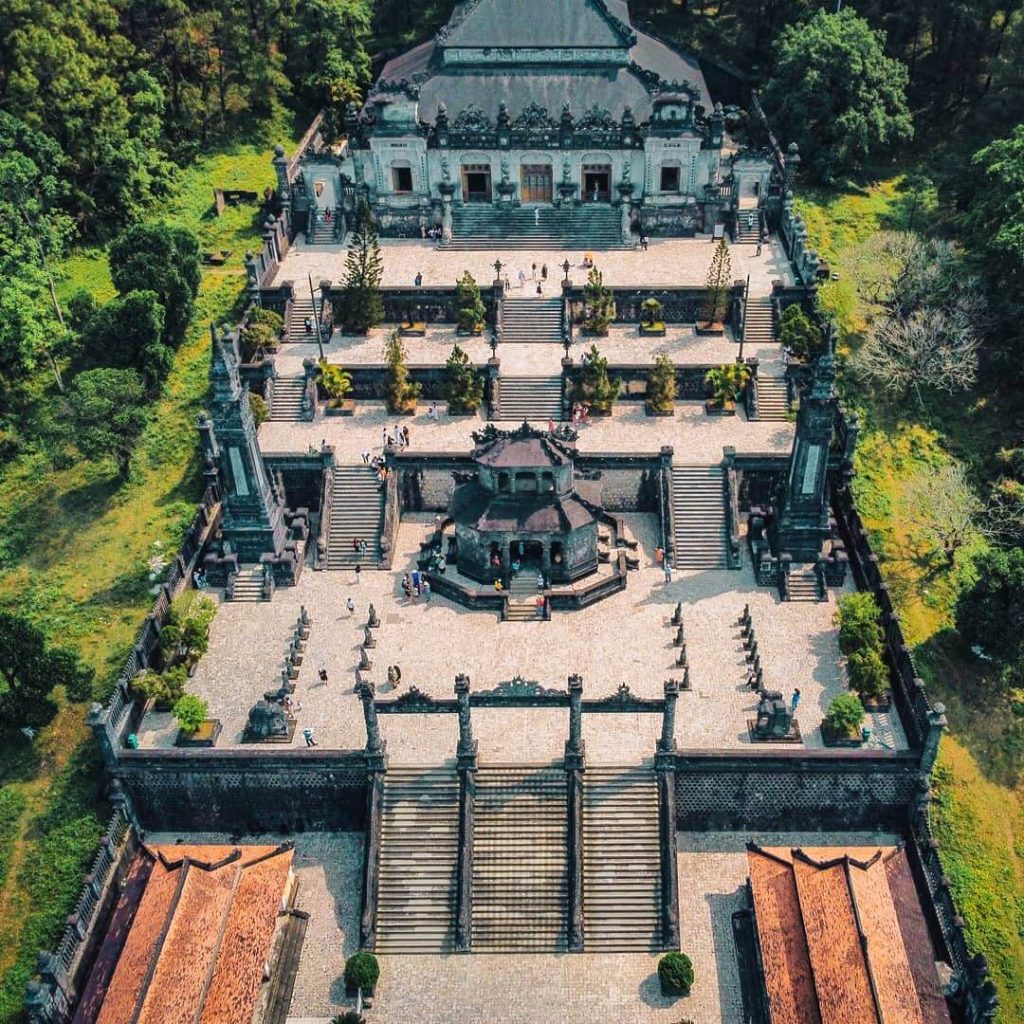
Where is Khai Dinh Tomb?
- Address of Khai Dinh’s Tomb: Khai Dinh – Thuy Bang – Huong Thuy – Thua Thien Hue, Vietnam
As one of the 7 most beautiful mausoleum systems in Hue, Khai Dinh Tomb or Ung Lang is located in Thuy Bang commune, Huong Thuy district, Thua Thien Hue province, located on Chau Chu mountain, about 10km from Hue city center.
How was the construction process of Khai Dinh Tomb in Hue?
Intertwined with history and the ancient beauty that has been preserved from generation to generation. To build such an elaborate tomb, it had to go through several stages.
Preparation for tomb construction
In 1916, when Khai Dinh ascended the throne, he ordered the construction of numerous palaces, residences, and royal tombs for the royal family and himself. To create his own unique tomb, King Khai Dinh had to consult with many geographers. After careful consideration, he chose Chau Chu Mountain as the location for his tomb. King Khai Dinh took a low hill in the front as the foreground and used Chóp Vung Mountain and Kim Son Mountain as the Left Azure Dragon and Right White Tiger. Originally, this tomb was called “Ứng Lăng,” but later, people renamed it Khai Dinh’s Tomb.
How long did the construction of Khai Dinh Tomb take?
The tomb was inaugurated on September 4, 1920, under the command of General Le Van Ba from the Do thong phu (Governor-General) office, and the construction process took 11 years. During the construction, there were many skilled craftsmen and famous artisans involved, such as Phan Van Tanh, Nguyen Van Kha, Cuu Sung,…
To finance the construction of the tomb, King Khai Dinh obtained government approval to increase agricultural taxes by 30% and used the additional revenue to fund the tomb’s construction. This decision was met with strong public opposition and left a significant mark in history.
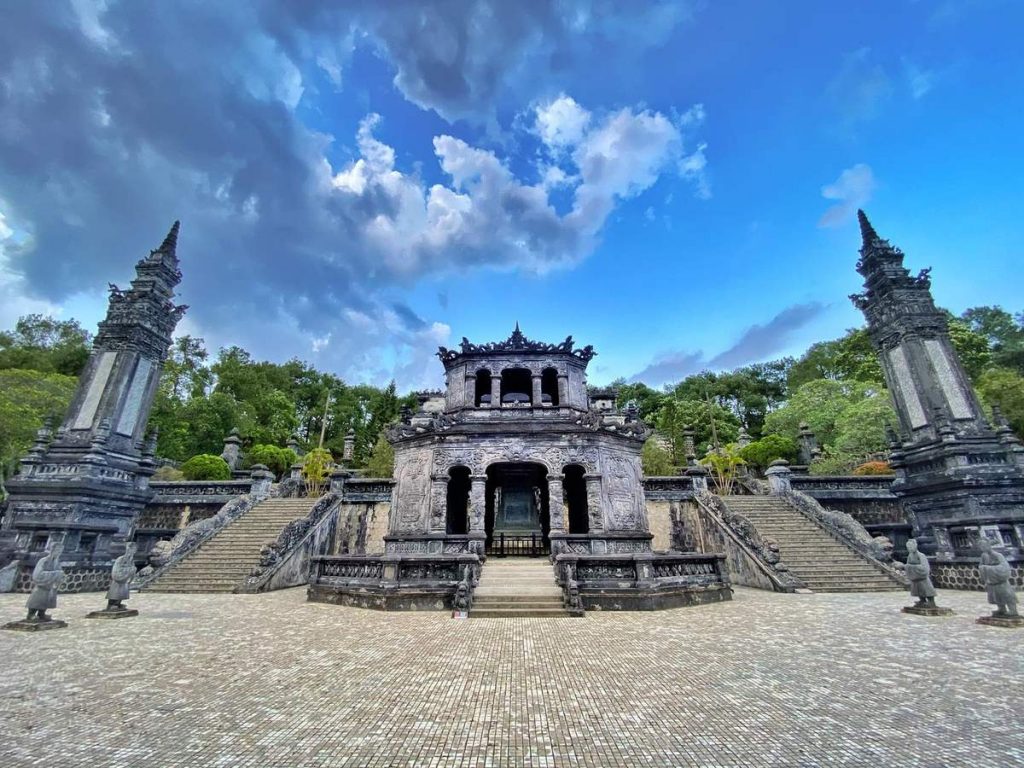
Unlike the tombs of other emperors, Khai Dinh’s Tomb has a smaller area with dimensions of 117m x 48.7m. However, what makes it special is the meticulous craftsmanship and the extended period of construction. Khai Dinh personally sent people to France to purchase iron, steel, cement, and even had ships go to China and Japan to acquire porcelain, colored glass, and other materials, all of which contributed to creating a magnificent work of art.
How far is Khai Dinh’s Tomb from Hue, and what are the transportation options?
As mentioned, Khai Dinh’s Tomb is not far from the central Hue, approximately 10 km to the southwest. There are various transportation options to get there, including motorbike, car, taxi, and bus.
If you’re traveling by motorbike or car, you can head straight on National Highway 49, and you will see signs leading to the tomb. If you prefer to take the bus, catch a bus on the southern side heading to Dong Ba Market – Tuan Market, and vice versa. This route will have stops at Khai Dinh’s Tomb.
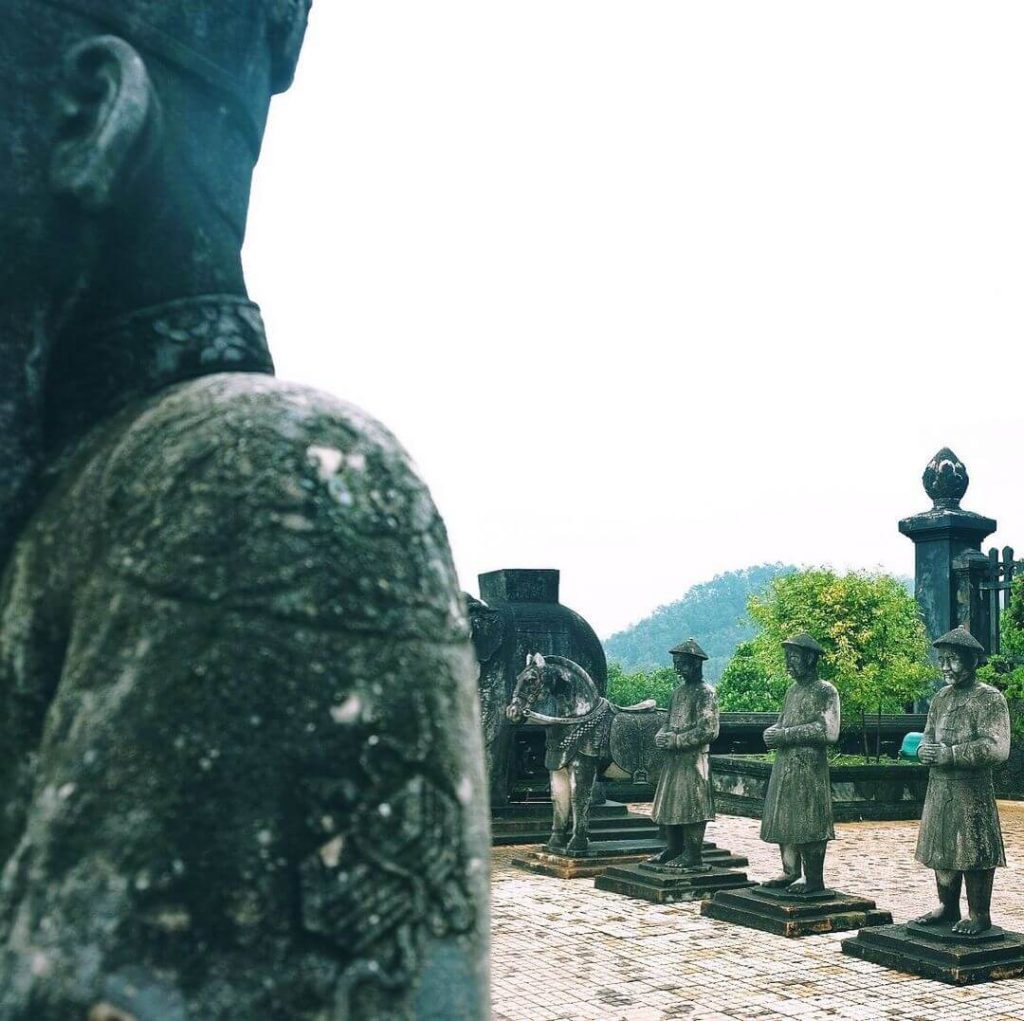
If you want to explore more locations and make your journey convenient, you can book a private car service with a driver in Hue from DanangPrivateCar.com. Our private travel car service will save you time, and our professional English-speaking drivers will pick you up and drop you off at your desired locations. Additionally, if you are in Da Nang, you can book a day trip from Da Nang to Hue to visit Khai Dinh’s Tomb and many other places
Explanation about Khai Dinh Tomb
Khai Dinh Tomb or Ung Lang is the resting place of King Khai Dinh – the 12th king of the Nguyen Dynasty.
With unique architecture, King Khai Dinh’s Tomb is a work that has reached the pinnacle of porcelain mosaic art in Hue.
The architecture of Khai Dinh Tomb in Hue was built in a modern way with cement, iron, and steel materials. The king himself sent people to France, China, and Japan to buy porcelain and glass to design the work.
King Khai Dinh ascended the throne in 1916 at the age of 31. Immediately after ascending the throne, he built many palaces, mansions and mausoleums for himself and the royal family such as Kien Trung Palace, An Dinh Palace, Truong An Gate, etc. Hien Nhon gate, Chuong Duc gate, especially Ung Lang.
History of Khai Dinh Tomb
On September 4, 1920: Khai Dinh Tomb was started to be built under the command of the Pre-Army Governor Le Van Ba with the participation of many famous artisans across the country at that time.
November 6, 1925: King Khai Dinh died and was buried in Ung Lang. Construction of the mausoleum was continued and completed by King Bao Dai.
1931: Tomb of King Khai Dinh was completed after 11 years of construction.
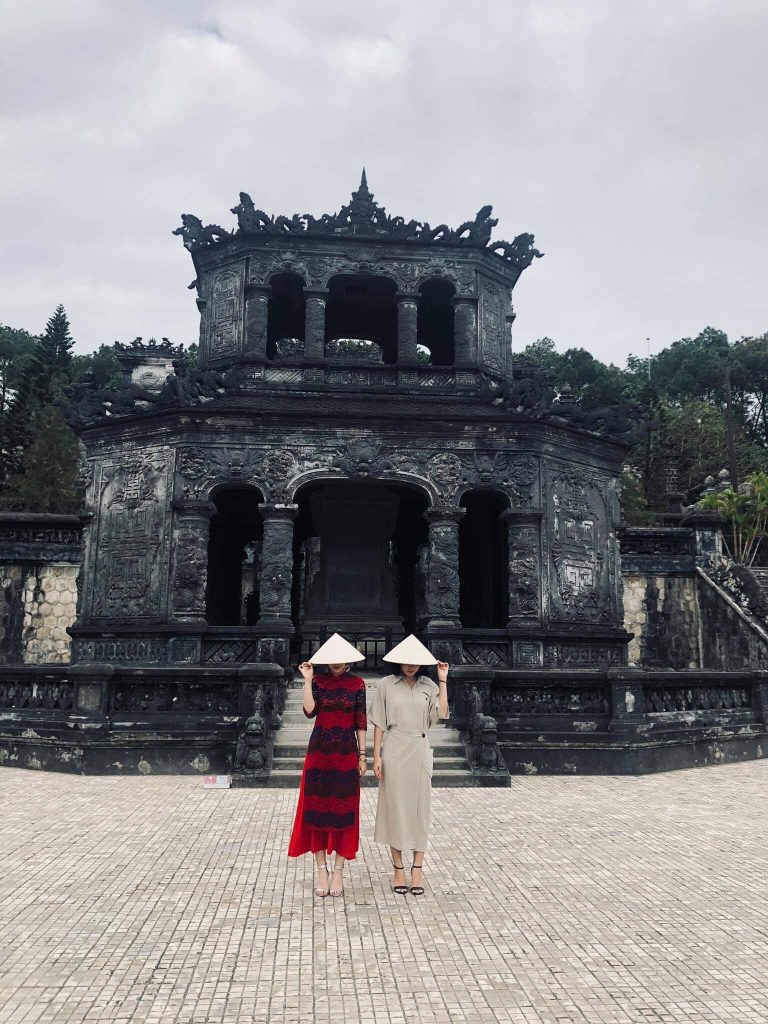
Ticket price to visit Khai Dinh Tomb
Because Khai Dinh Tomb belongs to the historical and cultural relic of the complex of Hue monuments, there is an entrance fee.
Specifically:
- Adult ticket price: 150,000 VND/time
- Child ticket price: 30,000 VND/way
Tour Visit Khai Dinh Tomb: Hue City Tour
Architecture of Khai Dinh Tomb: Unique and impressive
The whole of the mausoleum is a rectangular floating block reaching 127 steps high, with Thien Dinh palace as the center. Mountains, hills and streams of a large area around the Mausoleum are used as feng shui elements: criminal record, post-occipital, left dragon, right white tiger, clear path, water convergence, giving Khai Dinh mausoleum a natural landscape. majestic nature.
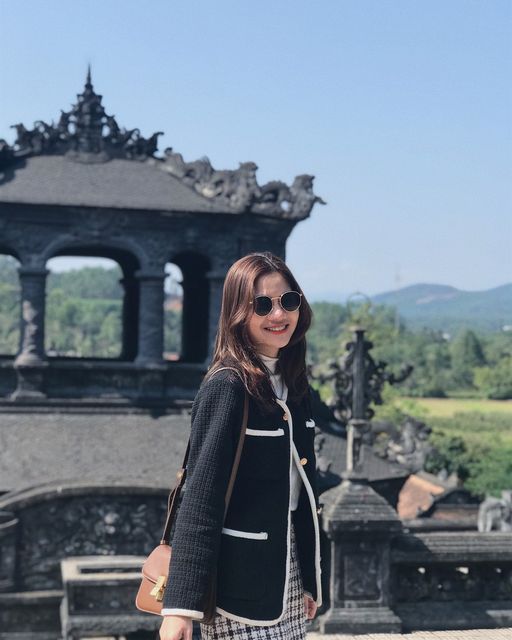
Compared to the mausoleums of the previous kings, Khai Dinh’s tomb has a much more modest area, with the size of 117 m × 48.5 m, but it is extremely elaborate and time-consuming.
To build the mausoleum, Khai Dinh let people go to France to buy iron, steel, cement, Ardoise tiles…, let ships go to China and Japan to buy porcelain and colored glass… to build works on this hill.
The architecture of Khai Dinh Tomb does not follow the principles of a certain school of architecture, but rather a bold combination of many architectural schools from Hinduism, Buddhism, Gothique to Roman… specifically:
- Those tower-shaped gate pillars are from Indian architecture
- Pillars in the form of Buddhist statues
- The surrounding fence is shaped like skinny crosses
- The stele house with its octagonal columns and arches is designed in a variant Roman style.
What is inside Khai Dinh Tomb?
Triple gate
Located on the first floor of the mausoleum, Tam Quan gate consists of 2 main works, Ta Tong Tu and Huu Tong Tu, which is a place to worship the gods who have contributed to the country.
To get to Tam Quan gate, you have to pass 37 steps. The architecture of Tam Quan Gate is a unique blend of European modernity and Vietnamese classicism.
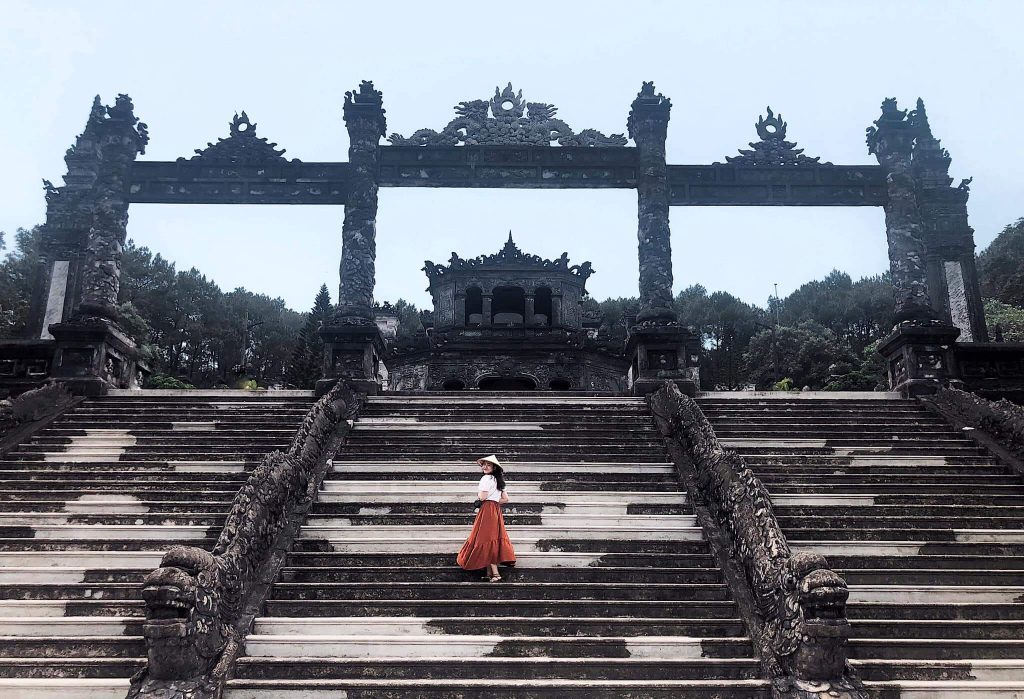
Nghi Mon and Bai Dinh yard
Moving through the next 29 steps, you will come to Nghi Mon and Bai Dinh courtyard. In the mausoleum you will see two rows of statues of soldiers and courtiers recreating an adoration ceremony of the Nguyen Dynasty.
These statues are all sculpted in a 1:1 scale
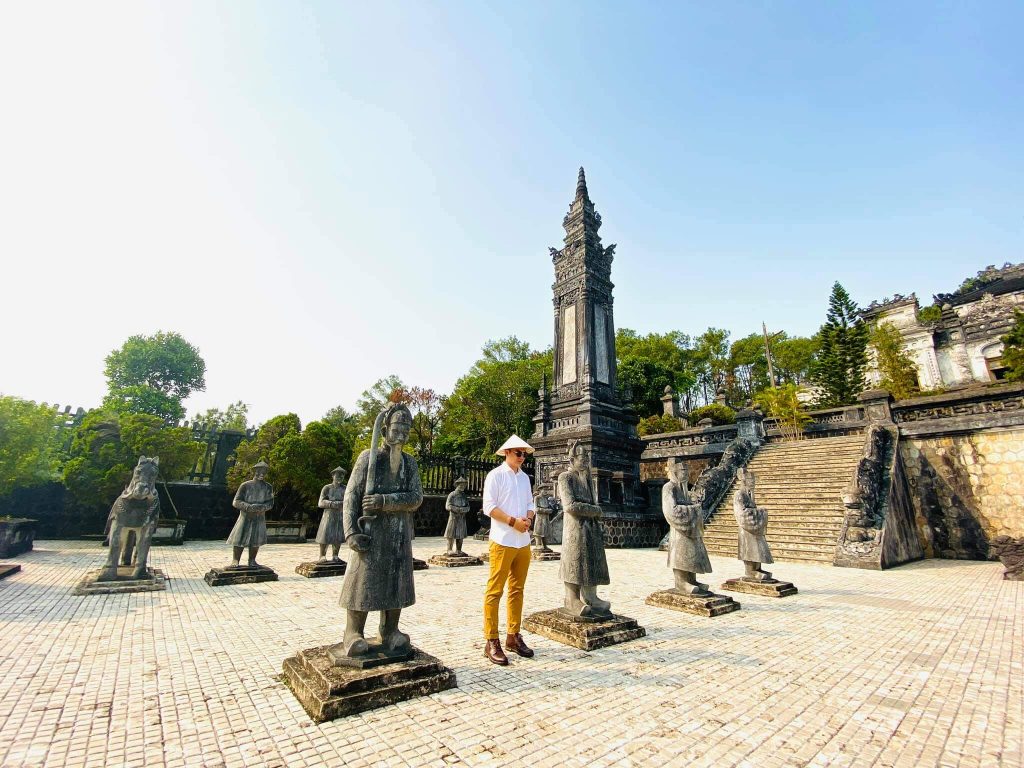
Thien Dinh Palace
Have you ever thought: What is inside Khai Dinh Tomb that attracts so many tourists? and the answer is:
Located at the highest position and the burial place of King Khai Dinh’s body, Thien Dinh Palace has the most unique design and high artistic value. The bow has a rectangular shape, the base is lined with marble.
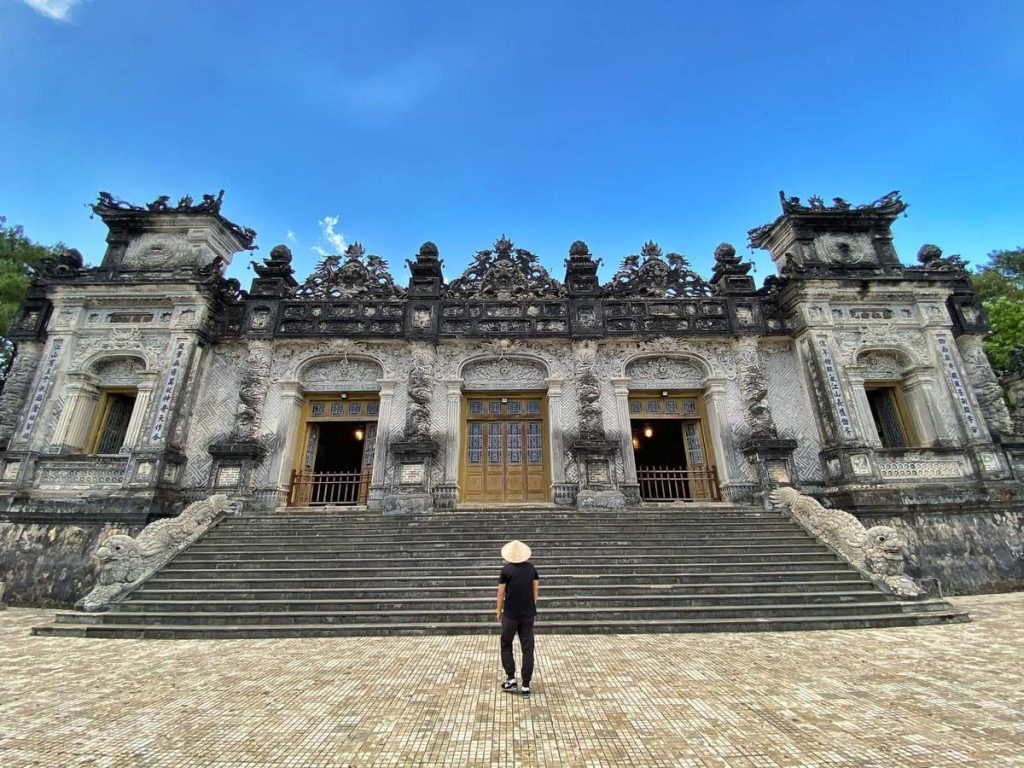
The entire interior is decorated with reliefs made from porcelain and glass and is extremely sophisticated and beautiful.
This work consists of 5 consecutive parts: the two sides are Ta and Huu Truc, the room for the soldiers to protect the mausoleum, the front is the relic citadel, in the middle is Buu Tan, the statue of the king and the grave at the bottom.
Khai Thanh Palace
As the place where King Khai Dinh’s altar is located, Khai Thanh Palace is cast in concrete. King Khai Dinh’s body is located right under this altar. The decorative decorative motifs around also bring a golden color like the palace. Above is an inscription with the name Khai Thanh Dien, below this palace is placed the body of the king.
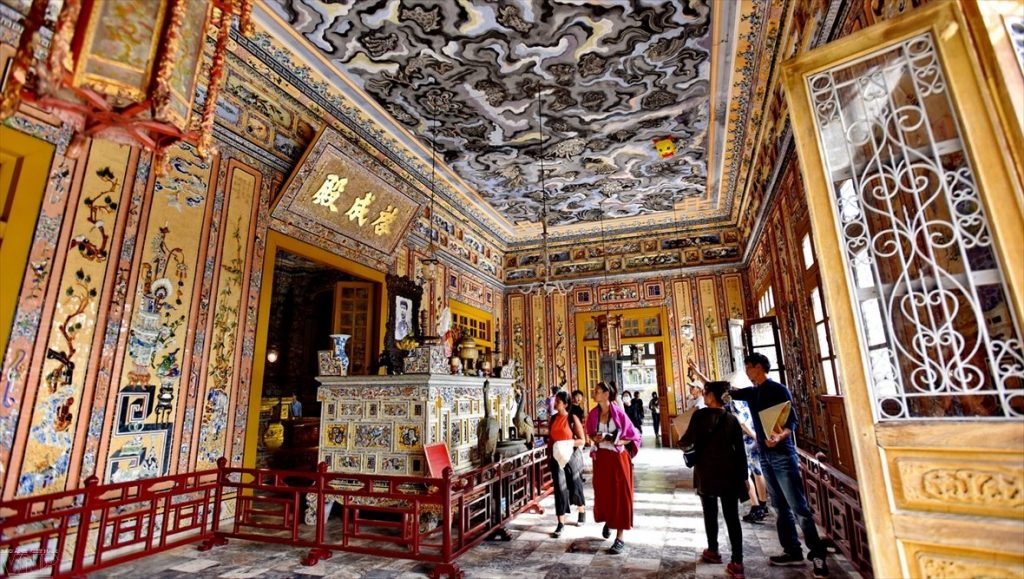
The bronze statue of King Khai Dinh
It can be said that Khai Dinh Tomb in Hue is highly innovative in its design. Inside the tomb, there are two bronze statues of the king. Specifically:
- The statue placed on the golden throne in Khai Thanh Palace was sculpted by two French artists and was cast in 1920, with a local Hue craftsman applying gold leaf.
- The standing statue was cast by a skilled artisan from Quang Nam in Hue. Initially, it was placed in An Dinh Palace, but in 1975, it was moved to Thien Dinh Palace.
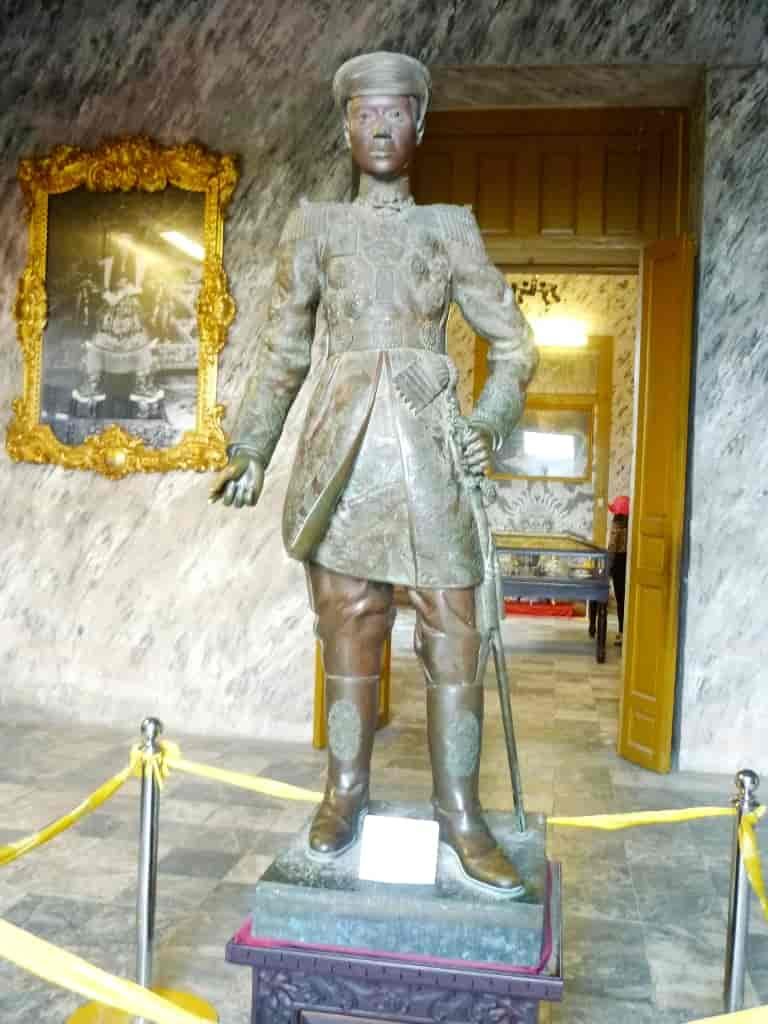
Experience visiting Khai Dinh Tomb
- It is recommended to visit Hue and Khai Dinh Tomb around January and February. At this time, the weather is pleasant, not too harsh, the transportation will be convenient.
- Visiting time takes about 1-2 hours, so you can arrange a route to visit other places at the same time.
- Note the slope of the steps, which are built quite steeply
- Refer to the beautiful photo angles before going to the mausoleum to get the best frames.

Tourist attractions near Khai Dinh’s Tomb in Hue.
When visiting Khai Dinh Tomb in Hue, you can also explore many nearby tourist destinations to gain a deeper understanding of the Ancient Capital region, such as:
- Minh Mang’s Tomb: This is another royal tomb in Hue and is known for its harmonious and serene setting. The tomb is surrounded by lush gardens, lakes, and intricate architecture, making it a peaceful and scenic place to explore.
- Thien An Monastery: Located on a hill near Huế, Thien An Monastery offers a tranquil and spiritual experience. The monastery is a great place to admire traditional Vietnamese architecture and enjoy a panoramic view of the city and countryside.
- Thuy Tien Lake: Thuy Tien Lake is famous for its abandoned water park, which has become an eerie but intriguing attraction. The decaying water slides and structures in the middle of a serene lake create a unique and somewhat surreal atmosphere.
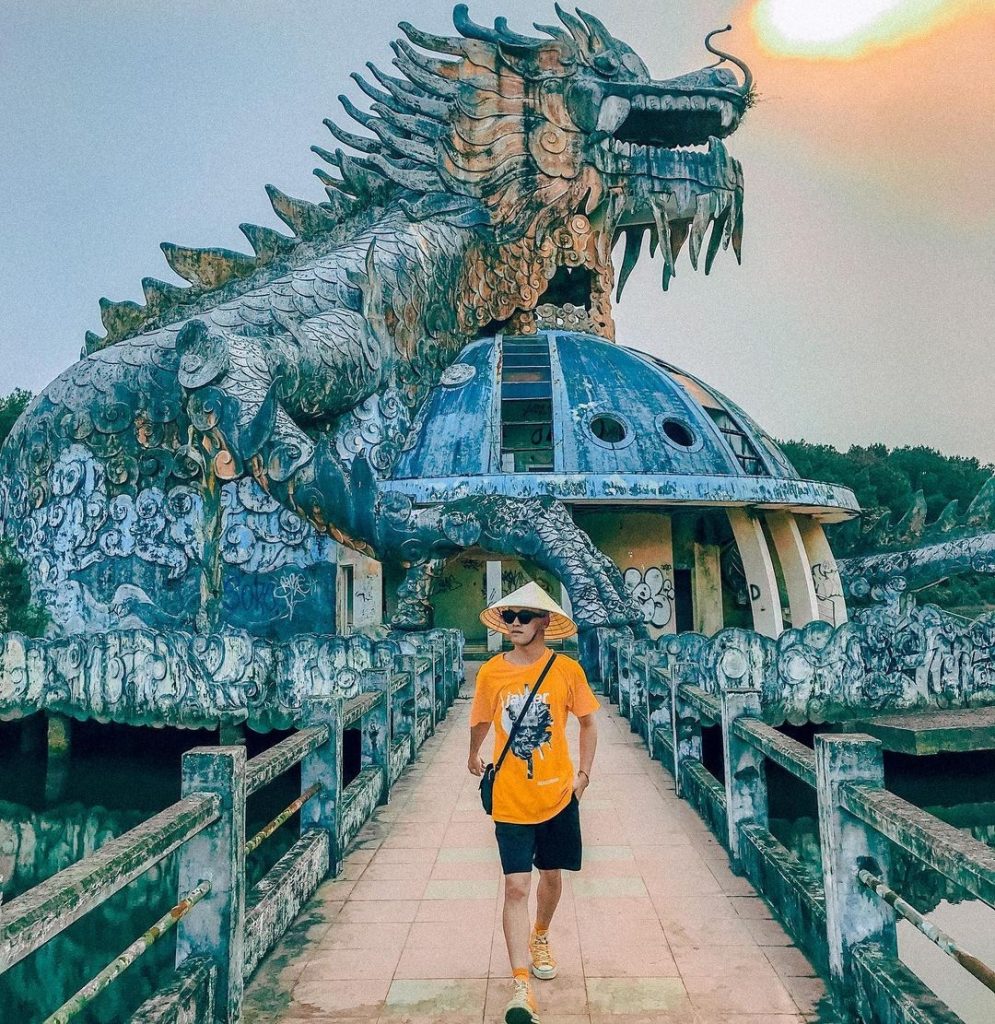
- Thieu Tri’s Tomb: This royal tomb is known for its simplicity and elegance. The architecture and layout of the tomb are less extravagant compared to others, but it holds its own historical significance and charm.
- Tu Duc’s Tomb: Tu Duc’s Tomb is one of the most elaborate and well-preserved royal tombs in Hue. It boasts beautiful gardens, pavilions, and a serene lake. The tomb’s design reflects the poetic and artistic nature of Emperor Tu Duc.
Sharing experiences for exploring Khai Dinh Tomb in Hue.
DanangPrivateCar.com will continue to share with you tips for visiting Khai Dinh Tomb in Hue so you can plan your trip effectively and have an experience while saving time and money.
When is the best time to visit Khai Dinh Tomb in Hue?
According to travel experience in Hue, you can visit the tomb during the summer months. However, Hue summers can be quite hot and sunny, which might make you tired. Therefore, if possible, plan your visit around January or February. During this time, the weather is more pleasant, not too harsh, and it will be more convenient for your travel.
How long does it take to visit Khai Dinh Tomb in Hue?
While it takes 3-4 hours to explore Minh Mang’s Tomb in Hue, you’ll only need 1-2 hours to visit Khai Dinh’s Tomb. The architectural complex of this tomb is not too extensive, but if you want to experience other nearby places, it might take half a day. In case you have limited time, plan your visit in detail to cover as much as possible.
Should you visit Khai Dinh Tomb in Hue with a guided tour or on your own?
In reality, Hue is quite easy to navigate as a tourist destination. If you enjoy the adventure of exploring independently and don’t want to be tied to a fixed itinerary, traveling on your own is a good option.
Things to note when visiting Khai Dinh’s Tomb in Hue
When visiting Khai Dinh’s Tomb in Hue, you should keep the following in mind:
- The steps of the three levels are quite steep, so be cautious when moving to avoid tripping and exhaustion.
- This is a popular spot for taking photos, so check out the best photo spots in advance to capture beautiful moments.
- When visiting Khai Dinh’s Tomb in Huế, take the time to learn about its history and architecture.
- Inside Điện Khải Thành, it can be quite dark, so adjust your camera’s brightness for balanced photos.
- It’s a place of respect, so choose appropriate attire that is not offensive.
- Additionally, protect the environment by not littering during your visit.
Along with other historical sites in the ancient capital of Hue, Khai Dinh Tomb has been recognized by UNESCO as a World Cultural Heritage. It is truly a unique masterpiece of architectural beauty, unlike any other, and is undoubtedly a must-visit destination when traveling to this promising land.

